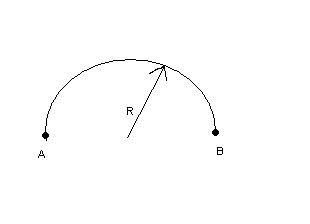actually i ws thinking why its not =4R/t ...
A particle moves along a semicircular path of radius R in time t with constant speed. For the particle calculate average acceleration.
answer given is : 2Î R/t2
why (2 x avg speed/time) is taken n not (2x avg velocity/time) ?
-
UP 0 DOWN 0 0 20

20 Answers
yes, i understud. thnx.
now i undrstnd, my main prob ws, dat i cudnt find initial and final velocities.
Does this make things any simpler?
Or even before that.. did u understand this?
Paromita.. sorry for replying so late.. I missed this thread
You are absolutely correct
See what is happening is that initially the ball is travelling upwards
later it is travelling downwards
If you see closely.. the ball is travelling in the opposite direction at both these times!
We find the speed.: Total distance travelled by the ball is the arc length = pi. R
Time = t
Speed = pi.R/t
Now if the top direction is given by j
then initial velocity is pi.R j
Final velocity is - pi.R j
no sir not at all... evn i kw this is going to help me..
vectors hv direction n magnitude.
sir if i take the origin at A then position vectors wud b
1) 0
2) 2R
see sorry for asking this.. do u understand what a vector is?
cos i want to know where you are getting it wrong!
Can you solve these!
1) What is the initial Position
2) What is the position at time t?
Dont get demotivated..... That is not what i am trying.
I am just trying to find out where u are missing the concept!
ok.. lets do this like this.. So that we can find out where you are wrong.. right?
Answer these:
1) What is the initial Velocity
2) What is the velocity at time "t"
Answer these two first .. ok?
no actually aftr posting dat.. it came in my mind that its writen in qn dat speed is constant... but the main thing i ws wondering is dat one above..
nn now i feel totally confused.. hehe..
well paromita..
Speed is constant.. (So speed change is zero)
I did not understnad you.. dont shy away from this one.. i think we need to do some fixing of basics here!
average acceleration=
V2-v1/t
where V2 and v1 are the final and initial velocities respectively
as they havvve same magnitude with opposite directions
v2-v1 = 2v = 2(Ï€R/t)
average acceleration = avg velocity /time = 2Ï€R/t2
Paromita:
Avg Velocity= "Change in Displacemtn"/"Change in Time"
Avg Acceleration= "Change in Velocity"/"Change in Time"
rohan..
i think u need to see the diagram then u will a ble to visualise..
now displacement is 2R,
avg vel = displacemnt/ time = 2R/t
1st of all i undrstnd u wrote dat,1st line, by mistake.
but sumhow i feel .. either u r not able to undrstnd wat i m asking (may b becoz i m nt clr on my part) or i m jus not undrstnding wat u mean to say... becoz wat u r saying isnt the answer of the qn i hd asked...
average velocity = average acceleration/(time taken)
remember it is always a vector
in this qn, avg speed,v= Î R/t
avg velocity= 2R/t
acc= 2v/t...
dats y i asked.. why acc= avg speed/t n not avg vel/t ?